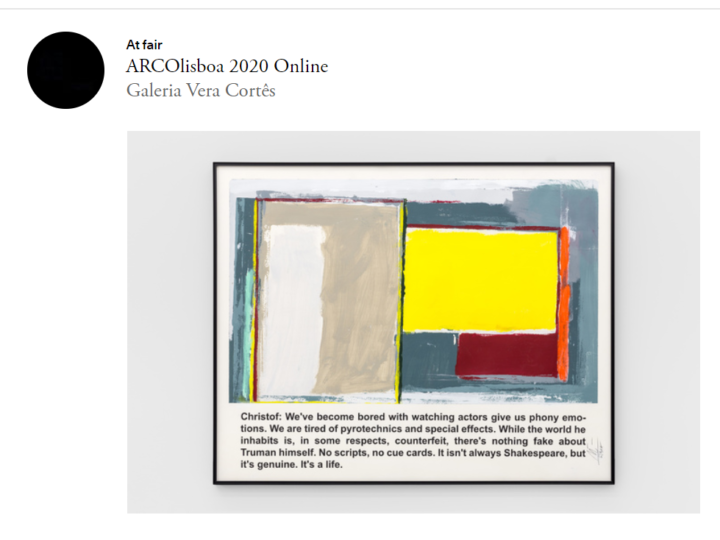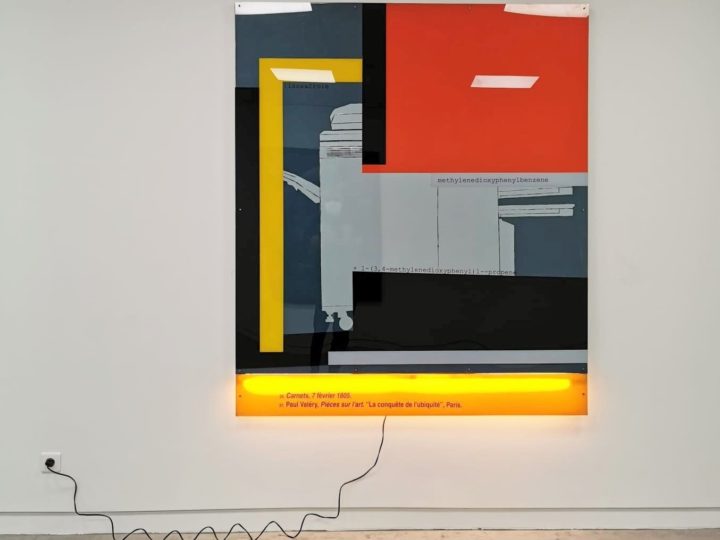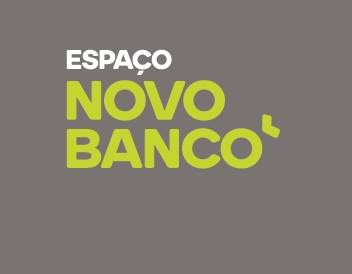THYLACYNUS CYNOCEPHALUS
07.07.22 > 10.09.22
Galeria Vera Cortês, Lisboa
Joao Louro: The end [Fim] of art is the beginning of art
by Joshua Decter, 2022
Joao Louro’s shapeshifting work – comprising paintings, sculptures, installations, objects, books – is infused with ideas and references sourced from art histories, film histories, literary histories, philosophical histories, linguistic histories, political histories, and scientific histories. Louro approaches art as a platform through which to explore that which exists beyond the realm of art. In this way, he participates in a long tradition of artists who have sought to reinvent the language of visual art by mining other cultural disciplines. For example, Louro’s longstanding fascination with cinema has provided him with a means of renegotiating the codes of painting, in an acknowledgement that as apparatuses of seeing, visualization, representation, abstraction, reproduction and perception, painting and cinema (as with photography) have been intersecting for well over a century. When Louro makes a painting, he is also making a painting about making a painting. Painting as meta-painting as painting. Louro’s paintings index – on both material and conceptual terms – the dialectic of painting and not-painting.
This leads me to one of my favorite works by this artist: “Blind Image #168 (Mark Rothko),” from 2010. It is Louro’s remake (to borrow a film term) of a 1969 Rothko painting. One cannot see the Rothko, but one can imagine it. Rothko degree-zero. In a sense, Louro has obliterated the [image of] the Rothko; it is na act of iconoclasm, of art historical heresy. Perhaps conceptually linked to Rauschenberg’s erasure of a de Kooning drawing, and Sherrie Levine’s appropriation and/or remaking of the work of other artists, Louro has appropriated the idea of a Rothko painting, yet does not disclose the image of the Rothko. The viewer is asked to imagine the missing Rothko painting, or perhaps to reassemble it from memory. A diferente kind of obliteration can be found in “From Left to Right #16” (2022), a painting that references a book documenting the testing of the first atomic bomb. The left panel of the work resembles a kind of mediated neo-gestural abstraction that might connote isotopes or radioactive fallout. Louro paints on the back of Plexiglas and then scrapes away the pigment, so that we are seeing the paint on the other side of the Plexiglas, which we perceive, somewhat paradoxically, as the front of the painting. At the bottom of the left panel, Louro has transposed the original image caption from the book, which reads: “BASE CAMP TRINITY TEST: A portion of the Alamogordo Bombing Range was chosen as the site for the Trinity Test.
This section of the test site was located at McDonald Ranch (RIGHT).” When we look to the right side of the painting/page, there is only a white monochrome, a void, a double obliteration: the image of the bomb test has been subtracted (literally through the removal of paint and the removal of imagery), which in turn allegorizes the destruction wrought by the bomb itself. And let us not forget that Louro produced a sculpture that replicates ‘Little Boy’: the atomic bomb dropped on Hiroshima. The bomb as an aesthetic object; the bomb as the ultimate anti-creative act. “Tesserato” (2022) takes as its source material a film still from the 2014 sci-fi movie, “Interstellar,” invoking a key scene in which Cooper has traveled through a black hole and has arrived at a four-dimensional space, referred to as a tesseract. Using the same painting technique as in “From Left to Right #16,” Louro does not provide us with a literal re-representation of the film’s imagery film, opting instead for a fragmented, abstract field into/onto which we can project. The caption at the bottom reads: “Cooper: No. No, not yet. But one day. Not you and me, but a people, a civilization that’s evolved beyond the four dimensions we know. [The tesseract closes Around him in a brilliant flash of light]” Is painting that brilliant flash of light that takes us from one dimension into another realm? Can art blind us… like an aesthetic atomic blast?
In 2022, there are still subtle tremors of the aesthetic earthquake triggered by Marcel Duchamp’s Readymades, such as the 1913 Bicycle Wheel (technically an Assisted Readymade). One irony is that this profound reconceptualizing of art was not actually seen by the public at the time of its making, and the original was eventually lost. Duchamp remade it in 1951 for a show at the Sidney Janis Gallery in New York, in a sense appropriating his own authorship. Likewise, Fountain (1917) never made it to public view in a bricks-and-mortar space, although the urinal was photographed by Stieglitz and published in the May 1917 edition of The Blind Man journal, thereby inserting the work into the world as a copy of an original may not have existed (to paraphrase Baudrillard), and indeed the authorship of Fountain is disputed. Duchamp did help to inaugurate what might be described as art in the age of conceptual reproduction (to paraphrase Walter Benjamin), a progenitor of meta-art: i.e., art that asks us to rethink received concepts of art. Louro’s art embodies this ethos, as evidenced by artworks that partake of the genealogy of Readymades such as Hades (2022), which is a structure that one might find on the street to protect a construction site, or as an instrument used for crowd control. Is Louro’s object a portal between earth and the underworld of Greek mythology? And consider the bicycle tire reconfigured as an infinity loop in Louro’s Bicicleta de Alfred Jarry (Alfred Jarry’s Bicycle) (2022), which conjures the eccentric early avant-gardist Jarry’s preoccupation with biking and alludes to his “pataphysics” (the science of imaginary solutions), perhaps suggesting that art is a non-science of imaginary solutions. This loops us back [to the future] of Duchamp’s bicycle wheel. Today, we can assuredly say that art itself – and art history – had become a kind of readymade material that can be used to make art.
How to represent the unrepresentable? How to un-represent the representable? Such questions come to mind when considering Louro’s enigmatic object, “Sudário/Shroud” (2022), composed of 1500 sheets of stacked paper. A reproduction of The Shroud of Turin is printed on the edges of the sheets, so that the image that we perceive on one side of the stack is comprised of 1500 distinct units of paper. Louro has merged photographic reproduction, printing, and sculpture into a hybrid object that eludes easy categorization. The Shroud of Turin bears the image of a man, which some believe was created by the dead body of Jesus somehow being physically imprinted on the fabric when it was used as his burial shroud after crucifixion. While it is conceivable that the shroud was used to wrap someone’s body, it cannot be Christ, because carbon dating and material/forensic analyses have concluded that the shroud dates from the 13 th or 14 th Century. And yet the shroud is a mystifying thing. There are various hypotheses regarding how the image came to be: painting, acid pigmentation, a medieval proto-photographic technique, dust-transfer technique, bas-relief, or Maillard reaction. Per Wikipedia: “The first possible historical record of the Shroud of Turin dates from 1353 or 1357, and the first certain record is from 1390 when Bishop Pierre d'Arcis in Lirey, France wrote a memorandum to Antipope Clement VII (Avignon Obedience), stating that the shroud was a forgery and that the artist had confessed.” It would be rather ironic if the Shroud was made by an artist to fool the world into believing that it not only carries the imprinted image of Jesus, but that it also holds biological traces of his body; in other words, the real blessed sacrament that supposedly offers proof of the historical Christ’s demise. Is it possible that the fiction of art has provided false evidence of the fiction of god? For believers, though, fiction is fact. In “Sudário/Shroud,” is Louro suggesting that the resurrection is just an infinitely reproducible image? We understand that while the photographic condition is in some way always related to death, the logic of reproduction also defies death, for the dead live on in/as images. The Readymade obliterated a traditional paradigm of art so that art could rise again as the idea that anything is potentially art. And, as Louro reminds us, art allows us to travel through imaginary black holes, and survive.
07.07.22 > 10.09.22
Galeria Vera Cortês, Lisboa
João Louro: O fim [End] da arte é o começo da arte
by Joshua Decter
O trabalho de João Louro, e as muitas formas que pode tomar – pinturas, esculturas, instalações, objetos, livros –, está impregnado de ideias e referências da história da arte, do cinema, da literatura, da filosofia, da linguística, da política, e da ciência. Louro aborda a arte como uma plataforma através da qual é possível explorar aquilo que existe para além do universo da arte. Desta maneira, ele participa numa longa tradição de artistas que procuraram reinventar a linguagem das artes visuais minando outras disciplinas culturais. Por exemplo, o longo fascínio de Louro pelo cinema deu-lhe os meios para renegociar os códigos da pintura, num reconhecer que estes aparatos de ver, visualizar, representar, da abstração, reprodução e perceção, da pintura e do cinema (assim como da fotografia) se intercetam há mais de um século. Quando Louro faz uma pintura, ele também está a fazer uma pintura sobre fazer uma pintura. Pintura como meta-pintura como pintura. As pinturas de Louro fazem um índex – tanto a nível material como conceptual – da dialética da pintura e da não-pintura.
Isto leva-me a um dos meus trabalhos preferidos deste artista: “Blind Image #168 (Mark Rothko),” de 2010. É o remake de Louro (pedindo emprestado um termo cinematográfico) de uma pintura de 1969 de Rothko. Não conseguimos ver o Rothko mas podemos imaginá-lo. Rothko grau-zero. Num certo sentido, Louro obliterou (a imagem) (d)o Rothko; é um ato de iconoclastia, de heresia da história de arte. Talvez ligada conceptualmente ao apagamento que Robert Rauschenberg fez de um desenho de Willem de Kooning, e às apropriações de Sherrie Levine e/ou o refazer do trabalho de outros artistas. Louro apropriou-se da ideia de uma pintura de Rothko, embora não revele a imagem do Rothko. Ao espectador é pedido que imagine a pintura de Rothko ausente, ou talvez que a refaça de memória. Encontramos um tipo diferente de supressão em “From Left to Right #16” (2022), uma pintura que faz referência a um livro que documenta os testes da primeira bomba atómica. O painel esquerdo desta obra assemelha-se a uma espécie de abstração neo-gestual mediada que talvez possa estar a fazer referência a precipitação radioativa ou de isótopos. Louro pinta na parte de trás da placa de acrílico e depois raspa o pigmento, de maneira a que o que vemos é a tinta do outro lado , que percecionamos, de certa maneira paradoxalmente, como a frente da pintura. Na parte de baixo do painel esquerdo, Louro colocou a legenda original da imagem do livro, onde se lê: “TESTE TRINITY BASE DE CAMPO: uma parte do campo de bombardeamento de Alamogordo foi escolhida como local do Teste Trinity. Esta zona do local de teste localiza-se no Rancho McDonald (DIREITA)”. Quando olhamos para o lado direito da pintura/página, vemos apenas um monocro branco, um vazio, uma supressão dupla: a imagem do teste da bomba foi suprimida (literalmente através da remoção da tinta e da remoção da imagética), que por sua vez alegoriza a destruição trazida pela própria bomba. E não nos esqueçamos que Louro produziu uma escultura que reproduz “Little Boy”: a bomba atómica lançada sobre Hiroxima. A bomba como objeto estético; a bomba como a ação anti-criativa por excelência.
“Tesserato” (2022) tem como material um still do filme de ficção científica “Interstellar” de 2014, que invoca uma cena fundamental na qual Cooper viajou por um buraco negro e chegou a um espaço com quatro dimensões, referido como um tesseract.
Usando a mesma técnica de pintura que em “From Left to Right #16”, Louro não nos oferece uma reinterpretação literal do filme imaginário dentro do filme, optando em vez disso por um campo fragmentado e abstrato em direção a, ou sobre o qual podemos projetar. Na legenda em baixo pode-se ler: “Cooper: Não. Não, ainda não. Mas um dia. Não eu ou tu, mas um povo, uma civilização que evoluiu para além das quatro dimensões que conhecemos. [O tesseract fecha-se à volta dele num feixe de luz incrível]”. Será que pintar esse feixe de luz tão brilhante nos leva de uma dimensão até outro domínio? Será que a arte nos pode cegar… como uma explosão atómica estética?
Em 2022, ainda existem tremores subtis do terramoto estético acionado pelos ready-mades de Marcel Duchamp, como a “Roda de Bicicleta” de 1913 (tecnicamente um ready-made assistido). Uma das ironias é que esta profunda recontextualização da arte não foi na realidade vista pelo público quando foi feita, e o original foi eventualmente perdido. Duchamp refez a peça em 1951 para uma exposição na galeria Sidney Janis, em Nova Iorque, de certa maneira apropriando a sua própria autoria. Da mesma forma, “Fonte” (1917) nunca foi tornada pública num espaço comercial, embora o urinol tenha sido fotografado por Stieglitz e publicado na edição de maio de 1917 de The Blind Man, desta maneira inserindo a peça no mundo como uma cópia do original que podia não ter existido (parafraseando Baudrillard), e na verdade a autoria de “Fonte” é disputada.
Duchamp ajudou a inaugurar o que pode ser descrito como arte na era da reprodução conceptual (para parafrasear Walter Benjamin), um progenitor da meta-arte: ou seja, arte que nos diz para repensar conceitos de arte preconcebidos. A arte de Louro incorpora este éthos, como comprovado por obras de arte que partilham a genealogia dos ready-mades como “Hades” (2022), que é uma estrutura que poderíamos encontrar na rua a proteger obras de construção, ou como instrumento usado para controlar multidões. Será o objeto de Louro um portal entre a Terra e o submundo da mitologia grega? E considerem o pneu de bicicleta reconfigurado como loop infinito na obra de Louro, “Bicicleta de Alfred Jarry” (2022), que conjura a preocupação com o andar de bicicleta e alude à sua patafísica (a ciência de soluções imaginárias), talvez sugerindo que a arte é uma não-ciência de soluções imaginárias. Isto traz-nos de volta (ao futuro) da roda de bicicleta de Duchamp. Hoje, podemos dizer com certeza que a arte ela própria – e a história de arte – tinha-se tornado uma espécie de ready-made material que podia ser usado para fazer arte.
Como representar o irrepresentável? Como deixar de representar o representável? Estas questões vêm à mente quando consideramos o objeto enigmático de Louro, “Sudário/Shroud” (2022), composto de 1500 folhas de papel empilhadas. A reprodução do Sudário de Turim está impressa nas margens das folhas, de maneira a que a imagem que vemos num dos lados do monte é composta por 1500 unidades de papel distintas. Louro fundiu a reprodução fotográfica, a impressão e a escultura num objeto híbrido que escapa a categorizações fáceis. O Sudário de Turim contém a imagem de um homem, que alguns acreditam ter sido criada pela impressão do corpo morto de Jesus no tecido, quando este foi usado como a sua mortalha funerária depois da crucificação. Embora seja verosímil que a mortalha tenha sido usada para envolver o corpo de alguém, esse alguém não pode ter sido Cristo, porque a datação por carbono e o material/análise forense concluíram que a mortalha é do século XIII ou XIV. Mesmo assim a mortalha não deixa de ser intrigante. Há muitas hipóteses relativamente à origem da imagem: pintura, pigmentação por ácido, uma técnica medieval proto-fotográfica, técnica de transferência por pó, baixo-relevo ou reação de Maillard. Segundo a Wikipédia: “O primeiro possível registo histórico do Sudário de Turim data de 1353 ou 1357, e o primeiro registo certo é de 1390 quando o bispo Pierre d’Arcis em Lirey (França) escreveu um memorando ao Antipapa Clemente VII (Papado de Avinhão), declarando que a mortalha era uma falsificação e que o artista tinha confessado”. Seria bastante irónico que a mortalha tivesse sido feita por um artista para enganar o mundo fazendo-nos acreditar que não só carrega a imagem impressa de Jesus, como também vestígios biológicos do seu corpo; por outras palavras, o verdadeiro sacramento abençoado que supostamente oferece a prova da morte de Cristo. Será possível que a ficção da arte tenha fornecido as provas falsas da ficção de Deus? No entanto, para os crente, a ficção é facto. Em “Sudário/Shroud,” estará Louro a sugerir que a ressurreição é uma imagem passível de ser reproduzida infinitamente? Sabemos que se a condição fotográfica está sempre alguma maneira relacionada com a morte, a lógica da reprodução também desafia a morte, já que os mortos continuam a viver nas, e como, imagens. O ready-made acabou com o paradigma tradicional da arte para que a arte pudesse renascer como a ideia que qualquer coisa é potencialmente arte. E, como Louro nos lembra, a arte permite-nos viajar através de buracos negros imaginários, e sobreviver.



